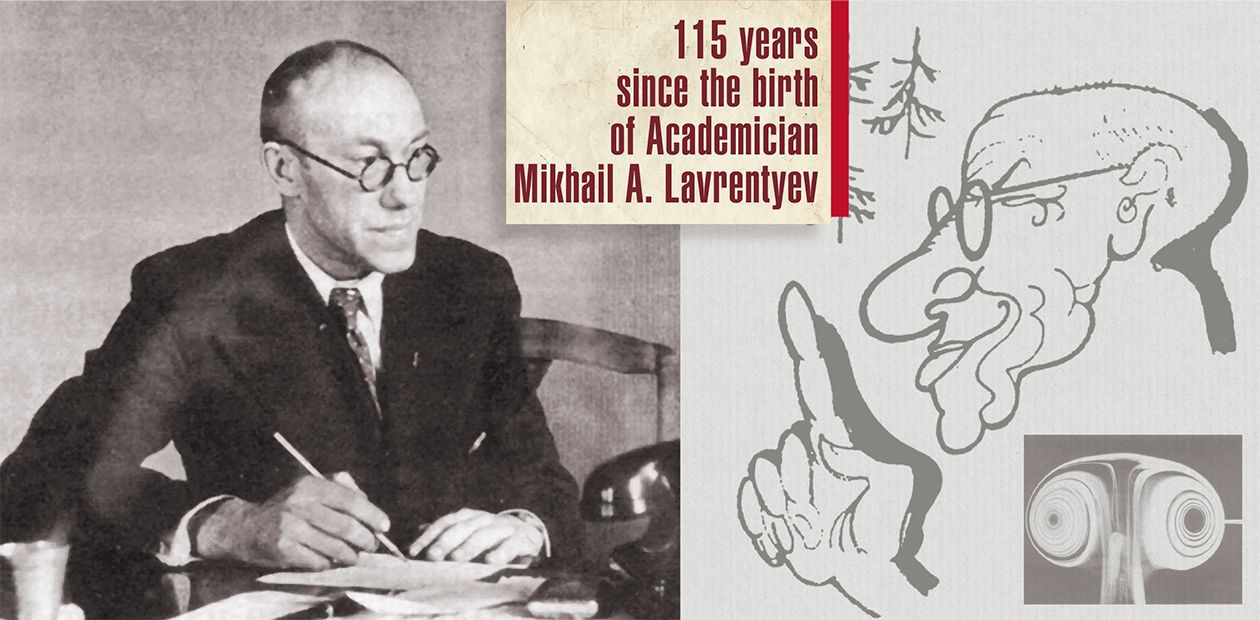The Controlled Explosion
The name of Academician Mikhail A. Lavrentyev is forever inscribed in the annals of Russian science, in particular, the history of the Siberian Branch of the Academy of Sciences. One of the main themes at the recent conference “Lavrentyev Readings on Physics, Mechanics and Mathematics,” which is held every five years by the Institute of Hydrodynamics SB RAS, the firstborn of the Novosibirsk Science Center, was the theory and applications of explosion, which were of great interest to Lavrentyev himself. His contributions to science include the hydrodynamic theory of cumulation with a paradoxical hypothesis that, at high pulse loads, the metal behaves like a liquid; the works on directed explosion, which are associated with the problem of crushing and moving of monolithic materials into a given direction; and the little known works on the development of a nuclear artillery projectile. To commemorate 115 years since the birth of Academician Lavrentyev, SCIENCE First Hand presents an article on the physics of explosion, a most diverse and multi-faceted theme, which has been developed for many years at the Institute of Hydrodynamics and continues to be popular today
Scientific literature understands explosion as a rapid conversion of an explosive material from the original state into the gaseous state, which is accompanied by a powerful dynamic and thermal impact on the nearby bodies. Widely circulating in the media, today the word explosion is primarily associated with severe devastation, and the term TNT equivalent is known even to preschoolers.
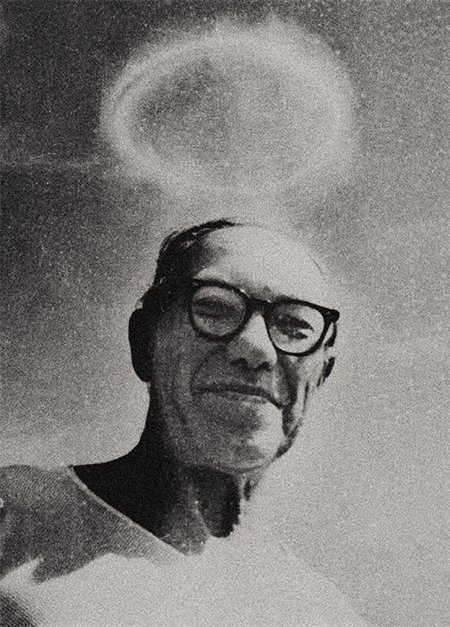 Indeed, uncontrolled explosions in the workplace and in the home are a danger because of possible deaths and injuries as well as damage to material objects. Throughout its multimillion-year history, the humankind suffered from forest and steppe fires caused by lightning strikes, although the man has always wanted to rein over the forces of nature and use them for their own benefit. The tamed fire proved to be a great helper; today heat and electricity is still produced mostly by controlled burning of various hydrocarbon fuels. Another part of our everyday lives is the tamed explosions: one can hardly imagine the life of modern people without the millions of tiny explosions that occur every second in the various internal combustion engines, including in such “explosive” devices as cars.
Indeed, uncontrolled explosions in the workplace and in the home are a danger because of possible deaths and injuries as well as damage to material objects. Throughout its multimillion-year history, the humankind suffered from forest and steppe fires caused by lightning strikes, although the man has always wanted to rein over the forces of nature and use them for their own benefit. The tamed fire proved to be a great helper; today heat and electricity is still produced mostly by controlled burning of various hydrocarbon fuels. Another part of our everyday lives is the tamed explosions: one can hardly imagine the life of modern people without the millions of tiny explosions that occur every second in the various internal combustion engines, including in such “explosive” devices as cars.
However, the human civilization owes not only its modern comfort but its very existence to an explosion. In search of an answer to the eternal question about the origin of the Universe, scientists could not do without explosion either. According to one of the theories, called the Big Bang theory, the Universe originated about 13.77 billion years ago. After being born in an explosion, it was a highly homogeneous and isotropic medium with an extremely high pressure, density (about 1093 g/cm3), and temperature (about 1032 K), and has been continuously expanding and cooling ever since. (For comparison, the maximum density of matter on the Earth is only 23 g/cm3 (in iridium), and the temperature on the Sun’s surface is 6 ∙ 103 K.)
What unique measuring instruments must be in place for researchers of explosive processes to cover this enormous range of parameters, from superdense solids to high-temperature gases! Scientists specializing in one narrow field would not cope with all the research tasks posed by explosion physics; this science requires a holistic approach. Lavrentyev and his colleagues were well aware of that when they created the Siberian Branch within the USSR Academy of Sciences. The principle of diverse and interdisciplinary research underlies the works of the Institute of Hydrodynamics, named after Mikhail Lavrentyev; a substantial contribution to the institute’s bank of achievements comes from researchers of explosive processes.
The goals set by the founding fathers are replaced by new ones; life goes on. Peering into the future, I would like to, once again, pay tribute to the older generation, who created the Siberian Branch more than half a century ago. Their principles (science—people—implementation) have never been forgotten by the subsequent generations of Siberian researchers and have proved to be highly important today. The present and future generations should know their history, especially the history of science, and take pride in its achievements. This article presents a brief history of explosion science and is dedicated to the 115th anniversary of the birth of Mikhail A. Lavrentyev, one of the brightest scholars who worked in this field.
Peaceful explosions
Lavrentyev developed a sustained interest towards explosion-related problems during World War II, while he was working on new weapons. In the years after the war, he pursued in-depth research into explosion processes and their applications in the national economy.
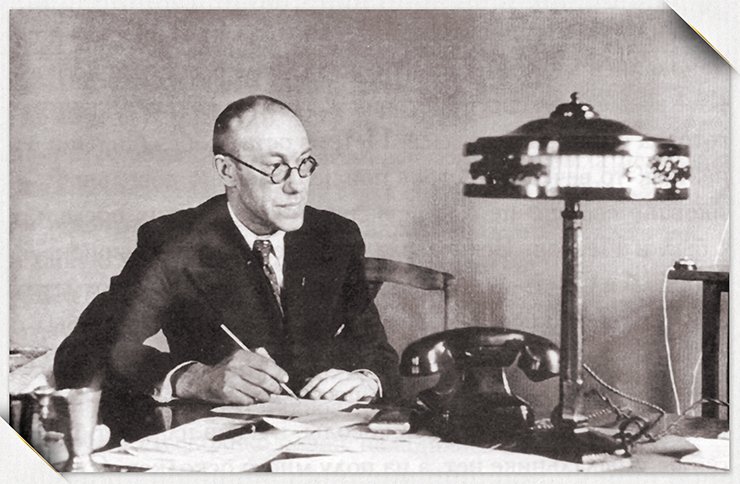
From the recollections of B. E. Paton, Academician of the RAS:
“When Lavrentyev returned to Kiev in 1945, he continued to be the head of the Institute of Mathematics, Academy of Sciences of the Ukrainian SSR, and pursue research in explosion science. He set up an experimental laboratory to investigate the quality of explosives and their applications, in particular, to determine the strength of welded structures of large thickness. There were also experiments on explosive forming of metal items. These works used pyroxylin powder waste... as a result, in the 1940s—1950s, with the direct participation of Lavrentyev, Ukraine began to use explosion for peaceful purposes, e.g., for building channels, tunnels, and roads; in the construction industry and agriculture.”
Lavrentyev continued to take interest in explosion processes in the subsequent years, when he moved to Moscow and began to teach at Moscow Institute of Physics and Technology. His student, a former researcher at the All-Russian Research Institute of Experimental Physics (Arzamas-16) and winner of the Lenin Prize, M. V. Sinitsyn reminisces: “...when in 1951 we completed our fourth year of studies, M. A. organized for us, as a pre-degree practical training, a trip to Kiev. There, at the Institute of Mathematics, he supervised the laboratory for explosive processes. Now I cannot remember the exact name of the laboratory; its head was N. M. Sytyi, a major specialist in blasting operations. The laboratory was located in a suburban settlement Feofaniya ... That settlement housed, apart from the resident population, two or three laboratories of academic institutes and a few summer cottages for high-level academics. In this serene, paradisaical place, we conducted our experiments right on the path the locals used to go to Kiev... The charge was usually suspended between the trees, and we walked in the opposite directions: if there were passers-by, we asked them to wait in a gully where they could not see the charge. After the explosion, we all returned to our business: the people went to the city, and we came back to our measuring instruments.
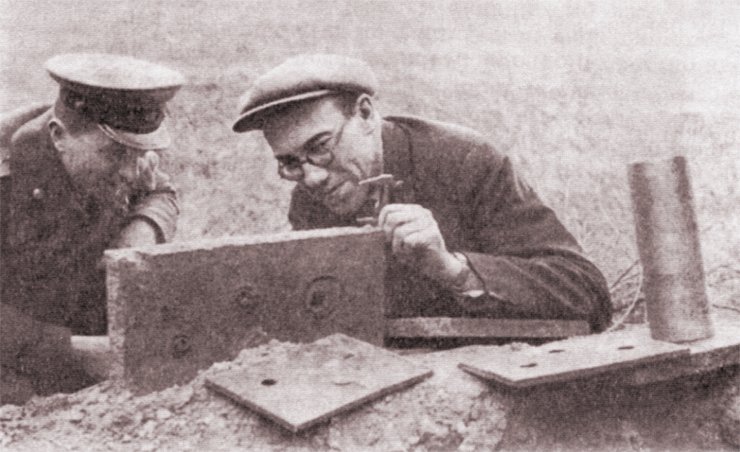
“Our week schedule was as follows: we received an assignment from M. A. (e. g., to determine the pressure field of a charge of a given configuration) and discussed the measurement techniques and the expected result. After that, M. A. often went away to Kiev. We made the necessary devices from the scrap materials we could find in the laboratory and in the neighborhoods. Used tanks, scrap pipes, lead seals and what not were rolled out in the laboratory workshop to make instruments for measuring pressure and momentum. We pressed explosive charges of the needed shape and size and conducted the experiments. Then we analyzed the results and prepared a report to M. A., who arrived at the appointed time.
“This approach showed us how one can use ingenuity and resourcefulness to obtain practical results even from most primitive means.”
Barrier against mudslides
Lavrentyev’s explosion studies gained a new impetus in 1957, after establishing the Siberian Branch of the USSR Academy of Sciences. As early as in the first months of his Siberian life, Lavrentyev laid the foundation for the further, extremely successful research in this area.
The main focus was the so-called directed explosion. An important thing in blasting operations is that the ground should move in the right direction. Lavrentyev had an idea how to arrange the explosives to achieve that result. Two of Lavrentyev’s students—V. M. Kuznetsov and E. N. Sher—were entrusted with putting this idea to practice. Experiments carried out in 1960 on the banks of the Ob Reservoir showed that the solution was correct.
From the recollections of B. G. Novikov, Institute of Thermal Physics SB RAS:
“One day, closer to autumn, I was walking past Lavrentyev’s cottage and saw him busy doing something at one of the many stumps near the side wall of his house. The stumps were high and thick. Apparently, the area for the house was prepared in winter, and the trees were sawed above the snow level. Lavrentyev stood up and walked over to the wall. I heard a clap, not very loud. The stump lifted up and then fell down slowly straight away from the house. The situation repeated with a few more stumps. I realized that the claps were small explosions... Later, in 1960, Mikhail Alekseevich made, at his very modestly celebrated anniversary, a brilliant scientific report that briefly yet clearly outlined a number of ideas and results, both his own and those of his students... One of them was the idea of directed explosion, which ensures the movement of medium of a given mass into a given direction without changing its shape during the movement. Only then I realized that in autumn 1958, near his house, Mikhail Alekseevich was testing the idea of directed explosion.”
Sometime later, under the supervision of Mikhail Lavrentyev, directed explosion was used to make a tremendous antimudflow dam near Alma-Ata.
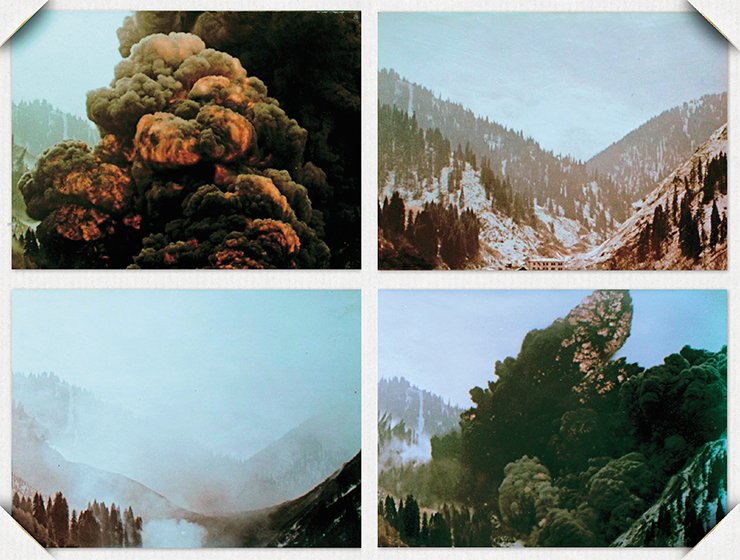
Here is how Lavrentyev himself reminisced about the building of this grand protective structure in Medeu:
“On my initiative, in 1959, the Academic Council on the Economic Use of Explosion was established within the USSR Academy of Sciences. I became the council’s chairman, and Academician M. A. Sadovsky was my deputy. Setting up this council expanded our opportunities in the implementation of scientific methods in technology and in the national economy. We established a good relationship with Soyuzvzryvprom and their chief engineer M. M. Dokuchaev.
“Right at that time, we were working on a project of using explosion to build an antimudflow dam on the Malaya Almaatinka River near Medeu, 15 km from Alma-Ata. Quite rarely, once in 20—30 years, under certain climatic conditions, the melting of snow in the mountains leads to the formation of lakes. At some point, the snow dam cannot withstand the pressure and breaks apart, and a huge mass of water (up to a million cubic meters), carrying rocks and boulders, slides down the river valley. The power of this flow of water and rocks is such that it can destroy a half of Alma-Ata (over 100 years, the city suffered three times from mudslides). In 1962—1963, we received warnings from hydrometeorological and seismic stations: large mudslides were expected. Blasting was the only way to quickly make a dam in the way of the mudflow and protect the city.
“Dokuchaev suggested that we make a dam by double explosion; a group of young people (led by Sadovsky and myself) conducted the calculations; and the project was submitted to the Council of Ministers of Kazakhstan. The Council of Ministers and the Central Committee of the Communist Party of Kazakhstan endorsed the project, but a number of academicians of the Kazakh Academy of Sciences as well as scientists specializing in various fields raised strong objections in the press. They insisted that the proposed blasting of 10,000 tons of explosives is itself more dangerous than the mudflow.
“The expert assessment was entrusted to the Explosion Council. We gathered several times in Akademgorodok and in Moscow; between the sessions, we made calculations for various explosive location options and the possible seismic, explosive and smoke implications (which the opponents of the explosion feared most).
“The decision in favor of the blasting was strongly influenced by the mudslide near Lake Issyk, 70 km from Alma-Ata... On July 7, 1963, Lake Issyk was visited by one of the republic leaders with his guests. A motorboat was waiting at the pier to take them to the other side of the lake so that they could see a recently built resort. The boat was ready, but the driver was absent. While they were waiting for him, they heard a roar and rumble from the mountains—a mudslide was coming. It was clear that the guests had to be taken away immediately. A few minutes after they left, a flow of mud and rocks fell into the lake. The lake overflowed; a hole formed in its natural stone dam; and a new mudslide, together with water from the lake, rushed down the gorge. The settlement of Issyk, located at the end of the gorge, was badly damaged, but there were almost no casualties since the residents had been warned about the danger.
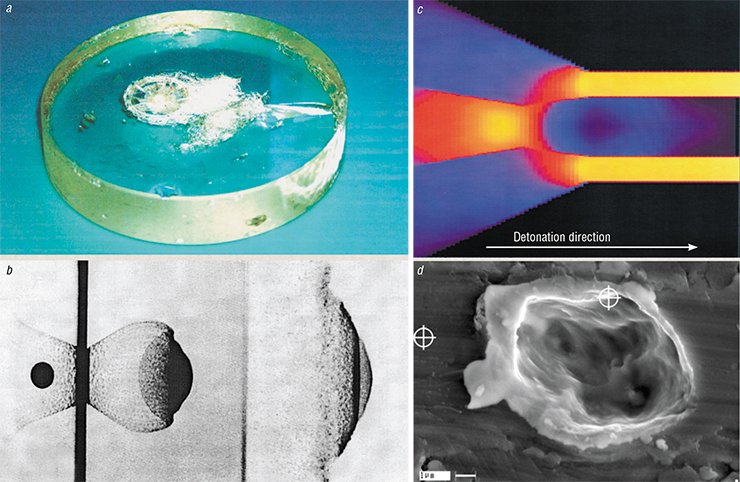
“Soon we were again summoned by D. A. Kunayev, who requested additional information about the explosion safety to make a final decision. A model explosion was performed in an area near the future dam. In haste we forgot to secure a shelter for ourselves and got hit by a shower of stones weighing 10 to 100 grams—we all tried to hunch down our heads and protect them with our hands...
“The blasting was performed in autumn 1966. We were standing on a mountain and saw everything—from the fire to the fractured rock mass that came off slope and fell into the valley...
“Seven years after the construction of the dam... there mas a mudslide in the Almaty Gorge, whose power was greater than that of all the previous events (it was carrying rock debris weighing up to 120 tons). All the traps above the dam were swept away. The reservoir formed by the dam and planned for 100 years was filled nearly to three quarters. The drainage pipes were clogged; the lake level was rising steadily; water began to leak through the dam.
“A commission was urgently called from Moscow; Sadovsky and me represented science... Headed by Kunaev, the republic leaders, representatives of industry, dam builders, military people and scientists gathered together on the dam. The main question was whether the dam could withstand the pressure of millions of cubes? Although everyone was convinced that it would and did not worry about the leakage (ordinary filtering through the riprap), measures were taken to drain water from the lake through the pipes... Two days later, one could safely go home.”
Space tasks
Explosion studies were also relevant for the strategically important goals of space exploration. In the early 1960s, with the rapid development of space research, scientists faced a challenge associated with spacecraft being hit by meteorites. The future Academician V. M. Titov, a student of Mikhail Lavrentyev, volunteered to solve the problem of meteorite impact simulation under the terrestrial conditions. Using the principles of cumulative charge, the scientist managed to accelerate small metal balls to space velocities. This made possible not only to study the possible consequences of rendezvous of meteorites and spaceships but also to assess the effects of meteorite impacts on the Earth and on celestial bodies.
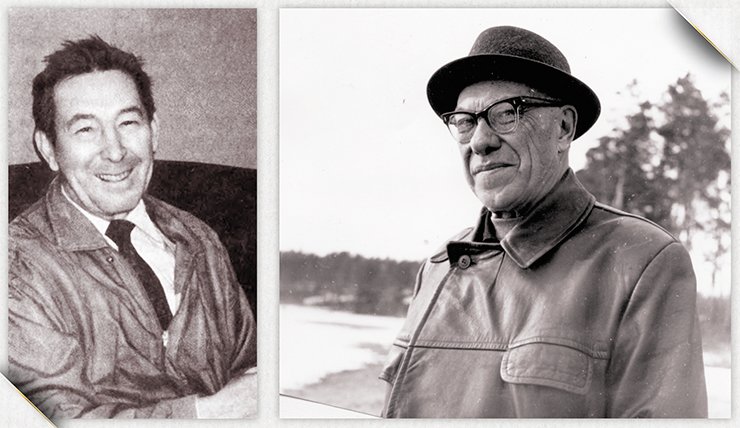
The history of these studies is given in the recollections of Yu. I. Fadeenko (Institute of Hydrodynamics), who was directly involved in the development of a technique for high-speed throwing of bodies:
“At the beginning of 1958, the Institute of Hydrodynamics was preparing to leave for Novosibirsk Akademgorodok... The Moscow scientific community had a most encouraging attitude towards the New Siberians; academicians suggested exciting research problems for the young scientists that were going to Siberia. It was the first time that the institute had got a space-related research theme. The country was about to launch the third artificial Earth satellite (ISZ-3), and Academician S. P. Korolev proposed Lavrentyev to work on a relevant task—to create artificial meteorites, i.e., rapidly moving particles that could be used to calibrate the meteorite sensors installed on ISZ-3. The velocity of these particles had to be no less than the first cosmic velocity, 7.8 km/s.
“The departure was a matter of months, but during that time, the student L. A. Lukyanchikov, who was then working on his degree paper, managed to obtain, by means of a cumulative explosion, a gas stream with a velocity of 13—14 km/s. However, there was no time to use it to accelerate solids particles; we had to load on the train...
“In summer 1958, we began settling into our new place in the woods near Novosibirsk. At times, Korolev’s task was forgotten, then it appeared again on the institute’s agenda, in concordance with the launch schedule of the objects carrying meteorite sensors. Each new attempt enhanced our respect for the difficulty of the task; we were like travelers in the mountains, where every trek uncovered new aspects of the ridge we were preparing to cross. At the same time, our ‘sport ardor’ was growing, and the bets grew higher. Until the director established a firm condition: ‘One gram, 20 km/s, and you get the State Prize.’ During one of these waves of enthusiasm, I remember, a recent MIPT graduate took part in the competition. A young father of twins, he had just been granted private accommodation space, which was in great deficit at the beginning of the construction of Akademgorodok,—two rooms in a simple wooden cottage. Inside, the walls were covered with cardboard and froze thorough during the 50-degree frosts. In the back room, the young mother was feeding the babies. In the front one, the young father (V. F. Minin, who later was appointed the director of the Institute of Applied Physics, Novosibirsk) arranged a powerful capacitor bank with a discharge energy of several grams of TNT equivalent. All the cardboard walls in that room were dotted with scraps of wire flying out of the electromagnetic accelerator at speeds of up to 3 km/s.
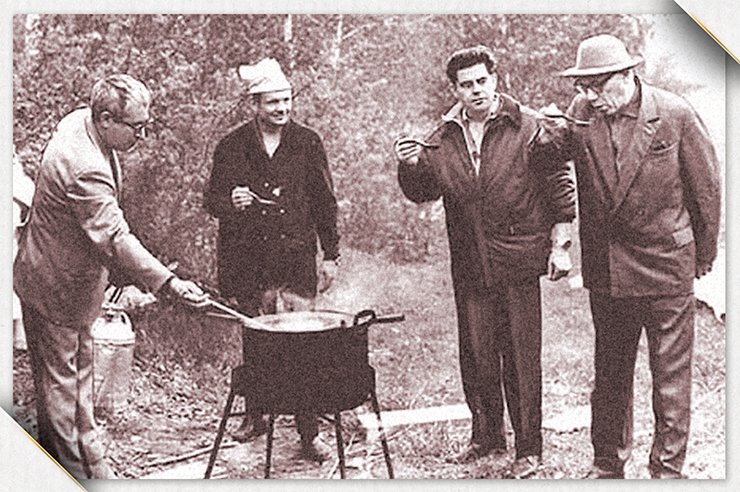
“It took much time to solve the problem. It pleases me to recall that I was able to contribute to its solution. I really liked one of the acceleration schemes that were tested on Lavrentyev’s recommendation. The explosive gas-cumulative accelerator captured my imagination with the amazing simplicity of its design. It consisted of a single piece, a pipe cast of explosive substance and shaped like a short barrel of a small-caliber gun. At one end, the charge was initiated by a detonator, and the body to be accelerated—usually a steel bearing ball—was placed at the other end. Then, a high-speed gas jet appeared along the axis of the detonating charge. The ‘meteorite’ was invariably destroyed, but its fragments flew off at a decent speed, up to 5 km/s. During one of the calm periods, when a fellow researcher engaged in these works (V. M. Kuznetsov, now deceased) switched to other things, I decided to bring my favorite scheme to fruition. I applied ‘item-by-item search’ through all possible combinations of parameters of the charge and the particle.
“It was the time of enthusiasts and workaholics. Almost no one counted the working hours, and we were able to make up to 10—12 experiments per day. A few months later, we achieved a success. We came to understand a fundamental thing: the particles to be accelerated must be an order of magnitude smaller in size than those we used before. Too big ones disintegrated during the acceleration; too small ones melted and burned in the gas cumulative jet. The optimum size was 0.15—0.25 mm.
“Fractions of a millimeter—it is easier said than done! Where could we get them? The industry produced metal balls of only 1 mm in diameter or larger; a special order would be prohibitively expensive. Powders did not suit our needs: particles with even a small deviation from the spherical shape were spun up in the gas jet and destroyed by the centrifugal forces. We had to make spherical particles ourselves, as a ‘kitchen-table’ effort, a well-known technological principle. The original material—metal wire—was transformed, by means of an electric explosion in water, into particles of various shapes and sizes. We used sieves to screen out the desired fraction. Then, the balls were separated from the trash by ‘racing’ on a sheet of glossy paper: the more regular the shape of the particles, the faster they roll down the slope... Soon we had a range of tubes filled with ideal particles of different fractions from a variety of metals. Particularly good-looking were the shiny nickel and tungsten balls; those would have fitted well into the showcase of a jewelry store...
“However, as soon as the microballs parted with the accelerating jet, they rapidly decelerated in the air... This called for a vacuum chamber, a pump, a dedicated room, staff... in short, the institute set up a special laboratory (headed by V. M. Titov), and things went smoothly. The very first experiment in the vacuum chamber yielded, as if on cue, the desired result: 7.9...8.0 km/s. We managed to do it by the time of manned flights.
“Soon we began to receive parcels from Moscow, one after another, with most unusual contents: portholes, skin of the Vostok spaceship, helmet and details of the astronaut’s suit. We fired our ‘meteorites’ at them and then sent back to the ‘customer’ for analysis and conclusions. The meteorite research experienced a short yet rapid boom until the end of the 1960s, when the Soviet space projects were cut sharply. During this time, we achieved throwing speeds of 12—14 km/s, established contacts with dozens of Soviet and foreign research organizations, and attained considerable progress in the study of high-speed impact events. Our blast test bench was visited by many delegations, including Soviet and American astronauts.
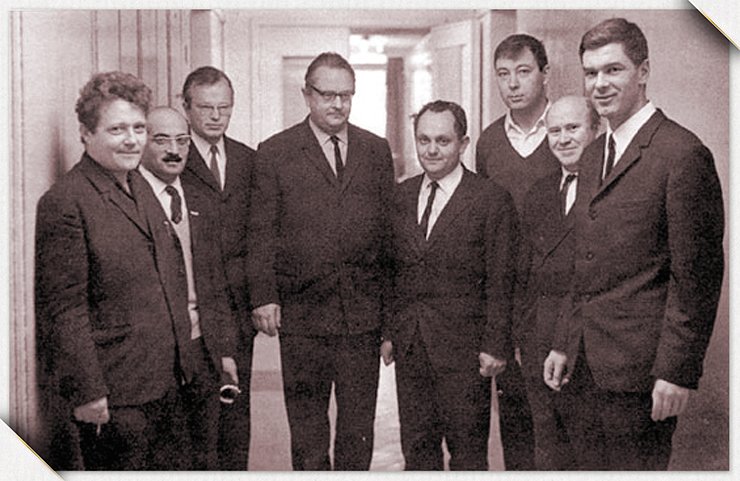
“I remember especially well the two polar opposites: Georgy Beregovoy and Neil Armstrong. Despite his age, Beregovoy was full of energy and desire for immediate action; he always wanted to stand as close as possible to the explosion demonstration bench. When examining the samples after the explosion, he was always inquiring eagerly for details; looking back at the Americans, he once asked in a low voice: ‘When will you shoot these things at the villains in space?’ Armstrong, the first man to walk on the moon, was impassive and silent as a moonstone... I asked him to sign a booklet, and his attendant said in surprise, ‘Well, lucky you are! Armstrong never signs autographs.’
“Years had passed before we could properly evaluate the place of our work in world science. It turned out that, in those days, laboratories of different countries conducted classified research to obtain jets and streams of substance with a mass and speed much higher than those of our artificial meteorites. Perhaps, the most impressive results were achieved by the developers of the so-called implosion design for nuclear bombs, who obtained huge velocities and energy concentrations during explosions of conventional explosives, which were directed ‘inward,’ towards the center of the nuclear device. When such a scheme was misaligned, at the time of maximum compression, jets escaped at speeds that could be higher than 20 km/s. But what kind of jets—vapor, foam, or liquid? It was impossible to use these designs to accelerate individual particles of known size and shape, to say nothing about calibration shootings and measurements.
“For several years, we were almost the only team who set for themselves a goal to obtain cosmic velocities with particles of known size and shape. Moreover, we sought to do that in a laboratory, not on a missile test site, where one can accelerate multiton blocks to cosmic velocities. In that area, our small team was, for a few years, on top of the world. Now, we know that we had reached the world level (at about 5—6 km/s) rather quickly and then moved up the record to 13—14 km/s. Alas! I did not contribute to that...
“Here, it makes sense to recall that this work, like many other exciting initiatives of that time, was started by students and thoroughly developed by 30—35-year-old men. How much can the energy and enthusiasm of the young, guided by the experience and wisdom of the old, give to science! (‘If youth knew, if age could.’)
“Of course, all these achievements have become outdated over the past three decades. Our records were beaten by the Americans, who first used a light-gas gun to accelerate a weighty ‘pellet,’ not a microball, 11 km/s and then used a special beryllium-coated cumulative charge for throwing. The higher the speed of sound in the coating material, the higher the speed of the cumulative jet. In this respect, beryllium is the champion among the metals; the head of a beryllium jet can reach speeds of 19 km/s. The Americans have learned to cut off by means of an explosion this head element from the beryllium jet and use the former as a calibrated impactor. Then, the time of meteorite studies and explosive acceleration methods was gone altogether. There was a dramatic change in the nature of the interest towards space research and, hence, in the goal-setting. The accumulated experience had long been sufficient to cope with the meteorite hazard during space flights and construct, where necessary, anti-meteorite shields. In the future, if researchers ever decide to revive the ‘high-velocity’ theme, they will do it for a yet unknown reason and, certainly, in a completely new form. Electrostatic dust accelerators for dozens of km/s? Miniature multistage rockets? Time will tell. The stagnation in this area cannot last forever. Sooner or later, the time will come for a new generation of young enthusiasts...
“P. S. The above was written in April 1999. Some things have changed since then. There has been much progress in the design of the telescopes and observational techniques. Our understanding of the ‘hard component of cosmic matter’ has changed radically. It seems that the new interest towards the cosmic-velocity impact is beginning to emerge within the assessment of the potential hazard of from comet and asteroid impacts on the Earth (January 23, 2007).”
Ice-breaking explosion
Explosion has proved to be a master of all trades; such a conclusion follows from the results of the studies conducted at the Institute of Hydrodynamics. Often they were a continuation of the works carried out long before and resumed at the request of industry organizations, which were addressed to the leaders of the Siberian Branch of the USSR Academy of Sciences.
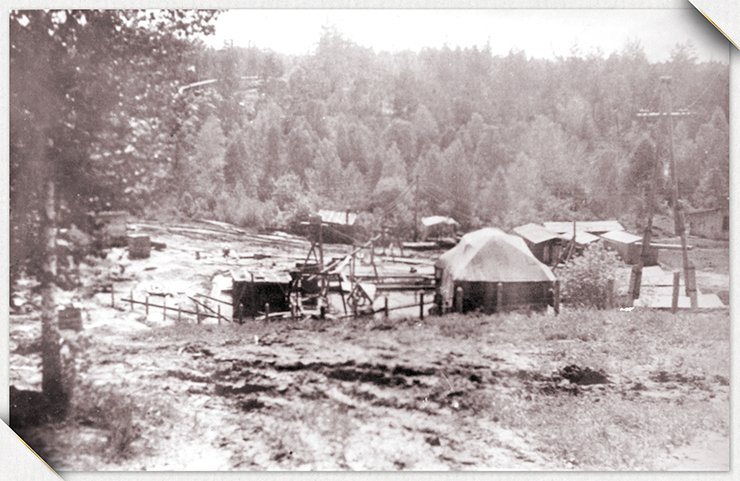
One of the practical applications of explosion, which was of interest to Lavrentyev, is related to breaking the ice cover on rivers.
From the recollections of S. V. Malashenko, winner of the State Prizes of Ukraine and the Russian Federation:
“Experiments were usually timed to coincide with the beginning of the flood on the Dnieper and were made ahead of the bridges in order to protect them from the damage associated with the drifting ice. Here, the researchers also studied the work of long charges, which were made either in the form of gunpowder ‘sausages’ in a textile casing, or the gunpowder was poured into a long ditch cut in the ice.
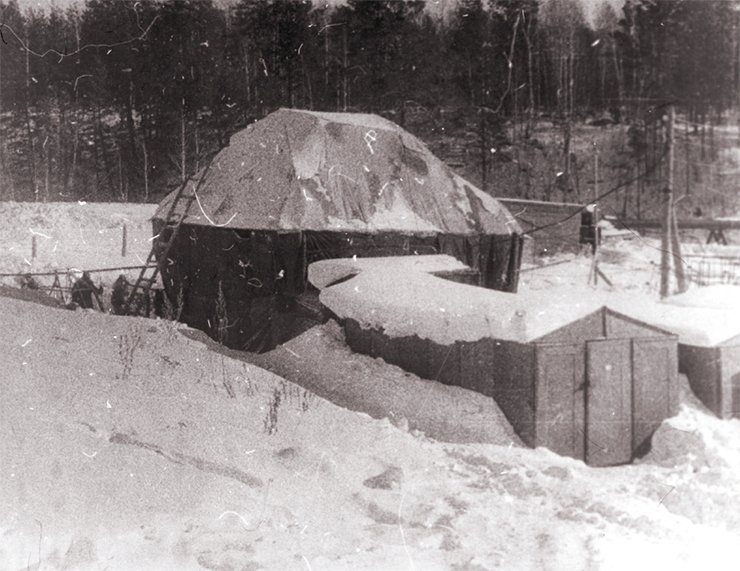
“I well remember the image: M. A. is somewhere on the ice at a distance, in the middle of the river, chopping with an ice pick. On the riverbank, worrying about him, are his wife Vera Evgenievna and his little daughter Vera, who have come to see the ice fireworks and... to protect the father.
“Vera Evgenievna’s favorite flowers wilted prematurely on the windowsill because the cone-shaped clay flowerpots behaved perfectly in the simulations of cumulative jets in water... The experiments with flowerpots and vases were made in the so-called frog pond, in a group, always with guests. A pot with the closed bottom hole and a charge tied to the bottom was let swimming in the pond and then blasted. The cumulative jet was clearly visible; the experiment was evaluated by its height, ‘above the aspen’ or ‘above the birch.’
“As a rule, two scientific results were derived from such an experiment. The guests began to believe into the existence of a special phenomenon—the cumulation, and M. A., together with the participants of the experiment, were amazed to find out that the frogs living in the pond could survive the explosion. They were thrown out on the bank, but they were alive.”
The Dnieper ice-breaking experiments were not forgotten in Siberia, but here researchers had to deal with the northern ice and much more ambitious tasks.
This work is detailed by G. S. Migirenko, winner of the Lenin Prize, Deputy Director of the Institute of Hydrodynamics in 1958—1973:
“Our laboratories huddled near the Zyryanka creek in temporary premises. We were happy, though, to have even those premises and tried to do research as much as we could. In particular, under the guidance of Academician Mikhail Aleskeevich Lavrentyev, our scientific youth studied the feasibility of applying explosive charges for breaking ice. It was important to establish a correspondence between the size of the charge and the ice thickness and determine what charges are necessary to make ice holes of a given size.
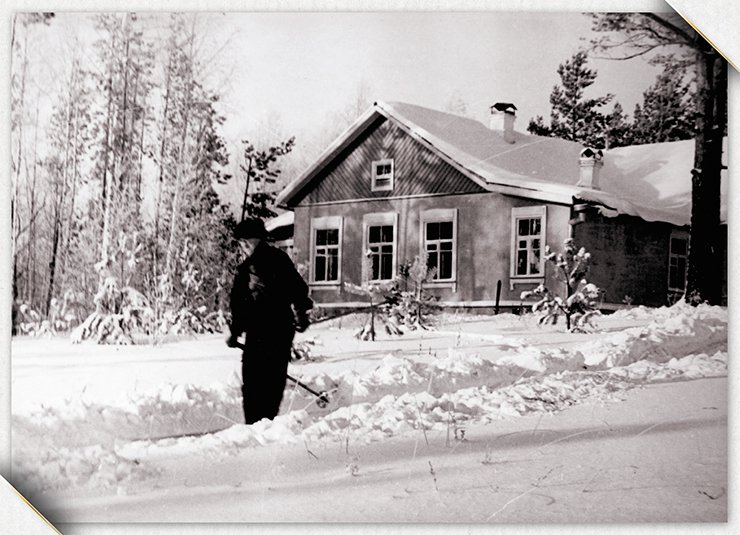
“In 1958/1959 we had a truly Siberian winter. The thermometers at the barracks that served as our homes sometimes showed –50 degrees centigrade. The ice on the Ob Sea was a meter thick. As the ice thickness was growing gradually, we were able to apply explosions to a whole range of thicknesses and derive a pattern.
“Mikhail Alekseevich was passionate about this work and often took us with him to the ice... He worked with an icepick, fetched charges, measured the holes... The experiments were to answer plenty of questions: What if we put the charge on top of the ice? What if we put in the ice? Or under the ice? At what distance? In short, they all boiled down to one question: How to make a maximum hole with a minimum charge?
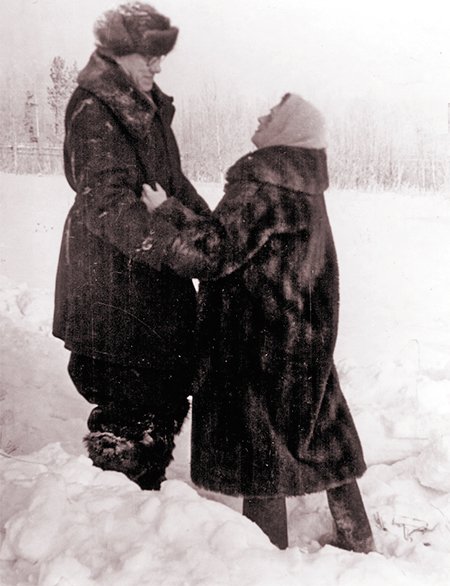 “...Soon we came to the conclusion that, for our study to be complete, we needed to try blasting thicker ice. However, near Novosibirsk, winter was coming to an end, and the ice was not growing. To make things worse, the snow that had accumulated on it began to melt and gradually erode the ice. At that time Mikhail Alekseevich came up with a suggestion: what if we go to the Kara Sea ice?
“...Soon we came to the conclusion that, for our study to be complete, we needed to try blasting thicker ice. However, near Novosibirsk, winter was coming to an end, and the ice was not growing. To make things worse, the snow that had accumulated on it began to melt and gradually erode the ice. At that time Mikhail Alekseevich came up with a suggestion: what if we go to the Kara Sea ice?
“I remember we were very confused, not without a reason... Now I think, we should have talked Mikhail Alekseevich out of this scientifically tempting idea or convinced him that we go alone. But once we tried to raise the subject, it became clear that any further discussion was pointless...
“We had to get to Dikson Island and, from there, to the ice near Sibiryakov Island, at the mouth of the Yenisei River. This area was of particular interest for us: the prevailing ice thickness was as large as 2 m... When there was navigation almost all over the Yenisei, at its mouth, obstructed by the Sibiryakov Island, there still was an ice bridge, which remained there for a long time (sometimes for a whole month)... This ice bridge reduced the already short shipping season... It was particularly challenging to deliver the explosives to the ice; we had to bring around 2 tons TNT, moreover, very quickly. This could only be done by air, but we could only procure one airplane. Without hesitation, Mikhail Alekseevich suggested we carry the explosives along. So, we first took them to Krasnoyarsk, then loaded onto the plane that brought us to Norilsk, from where the polar aviation carried us along the route Norilsk—Dikson—the ice bridge. We had to do the loading and unloading all by ourselves, for the involvement of outsiders might have revealed our secret. Mikhail Alekseevich was the most active participant of all the rigging works.
“The spring was in full swing in Krasnoyarsk. Having made ourselves comfortable on the trotyl, we headed along the Yenisei to the north... Soon we were on the ice, together with polar explorers from Leningrad.
“...Soon, everything became easy and rootine. We had very little time to sleep: we had to rush, as ice drifts on the Yenisei can be swift and turbulent. We could not protect ourselves from these hazards of nature. The mouth of the Yenisei River has a width of up to 15 km; only by straining eyes hard could we discern the outlines of the Sibiryakov Island. In case of trouble, it would not be easy to get to the land...
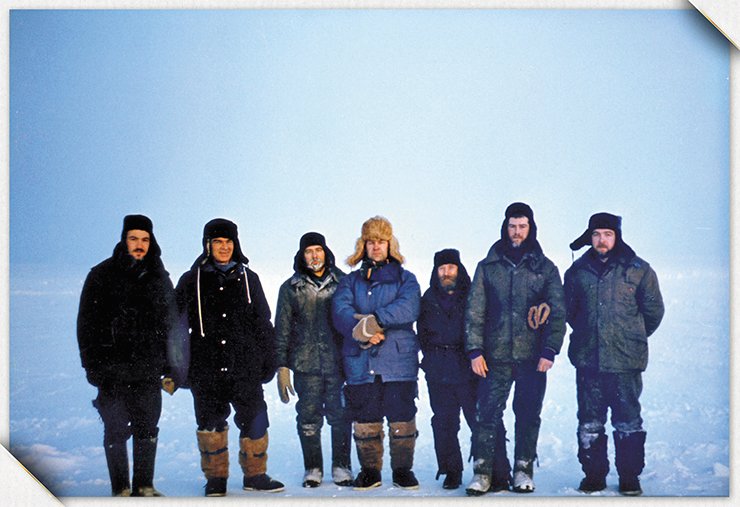
“Our neighbors from Leningrad were investigating the tension in the ice bridge. It turned out that the ice was contracting in some places and stretching in the other ones. We could not help but infer that the charges had to be put in those places where the bridge was stretching. In this case, after the explosion, it would fall apart and drift to the Kara Sea.
“We had found that under-ice explosions required much less explosive material. However, putting a charge under the two-meter ice was far from easy: we had to use both drills and small charges. The effect of explosions beneath the ice was exceptionally strong; to blow the ice field across, we had to tie charges in chains and float them under the ice with the current. Calculations showed that, using a relatively small total number of charges, we could remove the entire bridge from the river mouth. On the whole, the expedition provided material for both interesting scientific generalizations and useful practical applications” (Rasskazy ob uchenykh, 1965).
From detonation coatings to vortex fire suppression
The fundamentals for another, most promising area of explosion studies were laid by Lavrentyev in the mid-1950s, when he returned to Moscow from the Arzamas-16 Nuclear Center, where one of the research areas was a nuclear artillery projectile. Lavrentyev suggested to one of his students—B. V. Voitsekhovsky—that he should consider the “exotic” problem of spin detonation. Eventually, the work on this small task led to the revision of the classical detonation theory with a plane front and the discovery of the transverse wave and the multifront detonation. The results proved to be so fundamental that they were distinguished by the Diplomas of Scientific Discovery as well as the Lenin Prize, and the further development of these ideas in the 21 century, by the State Prize of the Russian Federation.
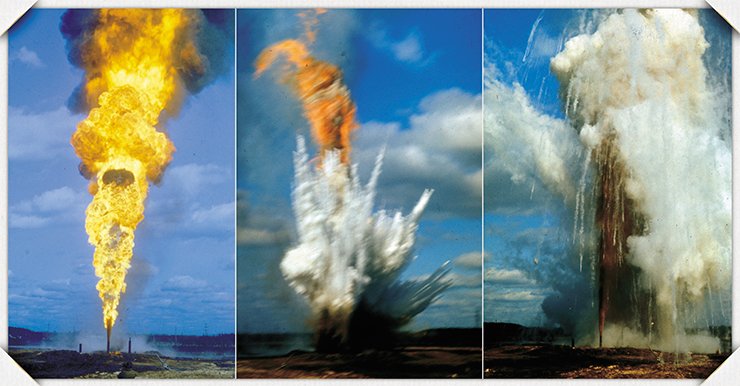
The subject of current research at the Institute of Hydrodynamics is the combustion and detonation of the so-called heterogeneous systems where the fuel and the oxidizer are initially in different phase states. Examples include droplets of liquid fuel (gasoline, kerosene, etc.) or solid particles (metals, coal dust, flour) in the atmosphere of a gaseous oxidizer (e. g., in air). Another example of a heterogeneous medium is gas-liquid mixtures, from foam structures to liquids with a small amount of gas bubbles. The latter system can appear as a result of methane leakage and buoyancy during the development of gas hydrate deposits on the bottom of the sea. (By the way, this phenomenon explains one of the mysteries of the Bermuda Triangle: ships get into a low-density foam column and lose their buoyancy almost instantly, before they send out a distress signal.) There are also diverse porous media in the form of a solid frame with interporous voids filled with gaseous or liquid components (such a structure is typical of rocks in the places of occurrence of oil and natural gas).
The practical application of the scientific results on the combustion and detonation of these multivariate heterogeneous systems is very important. Among the latest discoveries, particularly interesting is the experimentally detected effect of a full breakdown of detonation and combustion of a methane mixture with a curtain of inert fine sand. This method can be used to suppress accidental detonation of the methane–air mixture in mines.
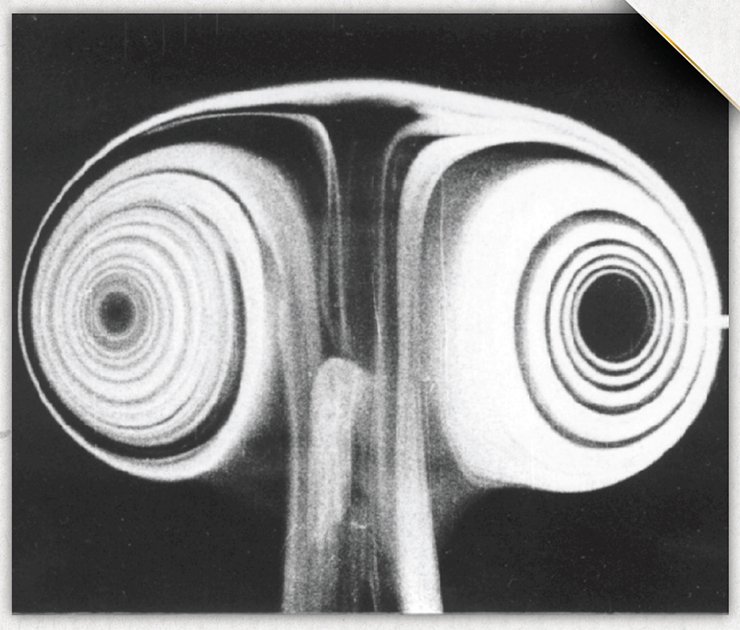
Gas detonation is widely used in the coating technology. The detonation gun is an open-ended barrel periodically filled with a combustible gas mixture, where one injects a portion of a powder material, i. e., the future coating. The mixture is initiated to produce a detonation wave that propagates along the barrel, drawing and simultaneously heating the powder particles. Flying from the barrel at a high speed, the particles collide with the sprayed surface to form a detonation coating.
A similar facility without powder is used to remove dust deposits from various surfaces, e. g., from electrodes that pick up cement dust at factories (after the shock-wave impact of the blast wave, this dust returns to the production cycle, which ensures conservation of resources and environmental safety).
Almost simultaneously with the detonation of heterogeneous systems, researchers began to investigate vortex gas motions. An example of the latter is the smoke rings, the blowing of which is considered particularly chic among novice smokers. One of Lavrentyev’s many ideas on the use of vortices and explosions was developed by his student B. A. Lugovtsov, who proposed a mathematical model for the motion and structure of vortex rings, which made it possible to calculate the parameters of the turbulent vortex ring.
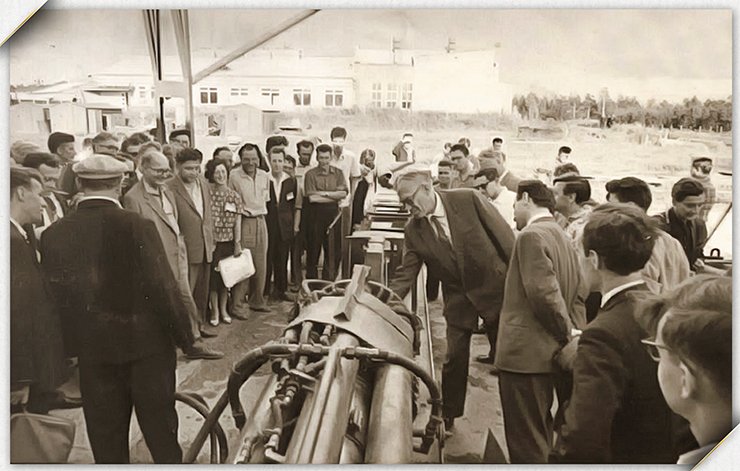
These studies, included many experiments, such as the blasting of 3 tons of air-dispersed gasoline on the island in the Ob Sea. The detonation of this two-phase gasoline–air mixture resulted, first, in a fireball with a diameter of 80 m, which then transformed into a “mushroom” and then, into a vortex ring, which rose to a height of more than 2 km. Based on these results, Lavrentyev suggested that people can use vortex rings of a large diameter to influence the atmosphere and cause rain.
These studies formed the core for the development of effective methods of fire suppression at oil and gas wells by means of vortex rings and pulsed jets of fire extinguishing powder. In September 1973, at a test site in Nizhnevartovsk, researchers conducted the first successful full-scale tests of the explosive method for the suppression of a burning oil fountain. The method was developed at Lugovtsov’s laboratory together with the Novosibirsk Fire Department of the Office of Internal Affairs. Nine years later, the vortex–powder method was used to extinguish a flare at the Yuzhnaya Tandyrcha gas well (Uzbekistan). The height of the flare was nearly 90 m, and its diameter, 15 m. Using 19 kg of explosives and 1,500 kg of fire extinguishing powder, the flare was suppressed within a few seconds, After they had fried for a month to extinguish it by conventional method.
Explosion: exquisite workmanship
In explosion science, the era of nano began long before the promotion campaign in the media. Thus, researchers from the Institute of Hydrodynamics were among the first in the world to publish results on the formation of ultrafine diamond particles in explosion products (Lyamin et al., 1988). This striking effect was observed after Lavrentyev had passed away. Together with NPO Altai, these studies were developed into a practical technology, for which the group of authors received the State Prize of the Russian Federation in 1994.
Another new research area is associated with the so-called explosion welding.
You can read about the history of these studies in Lavrentyev’s recollections:
“The railroad switch factory asked us to strengthen the mobile part of the switch by using explosion. The researchers A.A. Deribas, Yu.A. Trishin and E.I. Bichenkov quickly conducted the experiment. The switch that received the explosion treatment was put in place; in six months, it was clear that it could serve twice longer than usual. It was possible to arrange, within six months, the explosion strengthening of all the switches manufactured by the factory and, hence, make a solid profit. Unfortunately, the broad implementation of the technology was delayed due to red tape, and it took almost 15 years to set a factory shop for explosion strengthening.
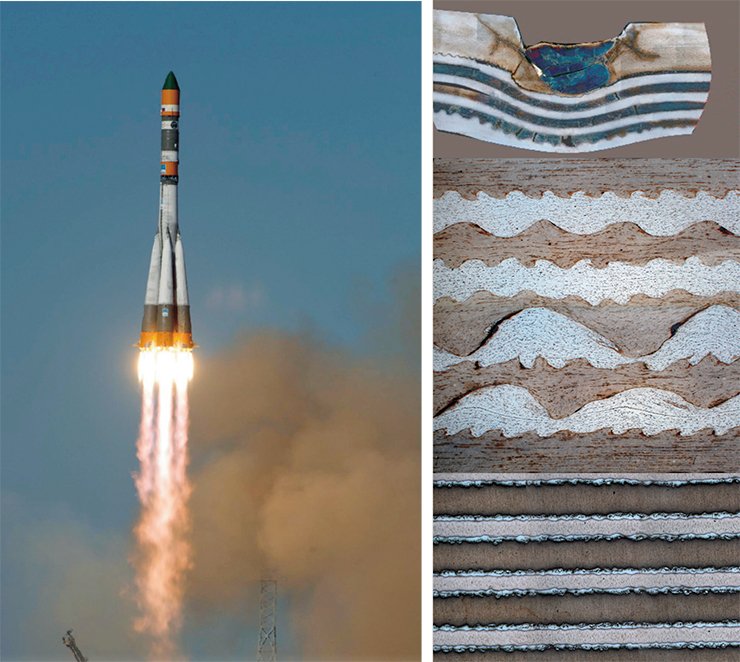
“The development of the strengthening method led, accidentally, to a new scientific discovery. Desiring to enhance the effect and avoid damaging the surface of the switch, researchers tried to reinforce the switch by throwing a metal plate on it by means of an explosion. The experiments showed unexpectedly that the metal plate often got welded to the switch. Deribas decided to take up the development of the theory and practice of explosion welding.
“A funny thing about this story is that, 15 years before the described experiments, similar ‘welding’ was obtained by N.M. Sytyi in my laboratory near Kiev. For our experiments we needed a copper blank 10 to 20 cm in diameter. We could not procure such a blank, but we had copper wire. Sytyi took a bundle of wire, wrapped it with a detonating cord and made an explosion. As a result, we had a monolithic blank of the required size (it was the first implementation of explosive compaction of materials). We observed similar welding in experiments with cumulative charges, but we treated these effects as a funny fact.
“Concurrently with our research, the studies on explosion welding began in the United States, and later, on a very large scale, in Sweden, Germany and Japan. Today our country ranks first or second worldwide in the number of different applications of explosion for welding, but remains on one of the last positions in the mass use of this technology for the production of critical bimetallic products, e.g., stainless steel. The reason is that it is inexpedient for the ministries to produce bimetals, which cost a fraction of the expensive metals with the same properties.”
Many things have changed since the time of writing these lines. It should be noted that there are two extreme wave propagation modes in a fuel mixture. The first one is laminar combustion with characteristic velocities of several tens of centimeters per second (e. g., the Christmas candle flame or lighter flame); the main underlying processes here are thermal conductivity and diffusion. The second mode is supersonic detonation with velocities of about 2—3 km/s for gas systems and 5--8 km/s (the escape velocity for the Earth!) for solid explosives, whereby the bow shock plays the leading role. In recent years, the Institute of Hydrodynamics has been doing intensive research in the field of the so-called emulsion explosives, where the filler is... tiny hollow balls. These explosives allow wide variations in the intensity of detonation waves and their impact on the surrounding objects.
The new approach has made it possible to upgrade the traditional explosion welding technology so that we can now obtain new bimetallic materials based on metal foils as thin as 100 microns. Could you imagine an explosion producing a thin foil (which is smooth, not warped, as one could expect)?
In recent years, one has found new applications for explosion welding such as the production of multilayer composites. For example, by alternating thin layers of different metals, one can make a composite with improved toughness, which can be used for the protection of military equipment. Combining the explosion welding technology with traditional heating makes it possible to obtain new structural materials such as intermetallic composites.
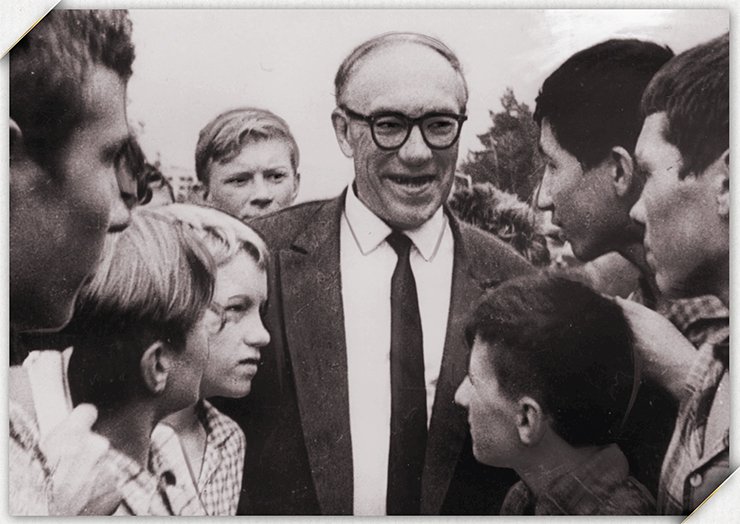
The Institute of Hydrodynamics has also mastered the technology of spark plasma sintering of powder materials with submicron or nanoscale grains (SPS method). The technology uses the combined effect of high pressure, temperature, and pulse currents and allows one to produce, e.g., dense high-temperature ceramics, with possible applications in the gas-turbine engine technology.
A great contribution to new explosion-related projects is expected from the unique technique of synchrotron radiation based study of explosive processes, which has been developed by the Institute of Hydrodynamics together with the Institute of Nuclear Physics SB RAS and the Institute of Solid State Chemistry and Mechanochemistry SB RAS.
In conclusion, I would like to emphasize that the principles laid down by Lavrentyev as the basis of of the first institute of Akademgorodok as well as the entire Siberian Branch of the Academy of Sciences worked successfully in the Soviet era and survived a most challenging test of time during the perestroika.
When in 1965, the Chairman of the USSR Council of Ministers A. N. Kosygin approved the act of acceptance for the first project stage of Akademgorodok, he wrote in ink on the official document: “To be noted that the construction works have kept within the approved budget.” Neither Skolkovo, nor RUSNANO, nor the Olympic complex in Sochi, nor the Vostochny Cosmodrome, nor many other objects operated by the modern “effective managers” can claim that. In this respect, the allegation that the Academy of Sciences cannot manage its property efficiently, which has been one of the core reasons for the recent devastating reform of the Russian Academy of Sciences, bursts like a soap bubble.
The founder of the Siberian Branch was not only an outstanding scientist and an excellent organizer but also a true teacher of science and life for several generations of young researchers—his students and followers. Sown in fertile ground, Lavrentyev’s ideas continue to evolve: researchers find solutions to the previously posed problems and formulate new ones, which bring forth new generations of scientists. This is Lavrentyev’s heritage, whose value is only growing over time. That is why Mikhail A. Lavrentyev is remembered and appreciated by everyone who has ever known him and his scientific search.
We do honor and remember this great man!
The editors thank Natalia Bogunenko for the idea of the publication and the large work on the selection of historical materials


